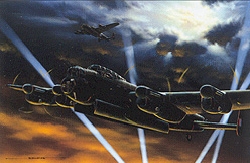|
|
| Night Raiders |
|
 |

|
 |
|
|
| DESCRIPTION |
 |
| 16 x 11.5 Inch Collector Size Unframed Lithograph $40.00
Anxious to retaliate against German bombing raids on Great Britain, the RAF devised a strategic bombing strategy of its own. Sir Arthur Harris, Chief of the RAF's Bomber Command, stated: "The Nazis entered this war with the rather childish delusion that they were going to bomb everyone, and nobody was going to bomb them...they sowed the wind, and now they are going to reap the whirlwind." The Avro Lancaster Mk. B.I. heavy bomber, certainly one of the most important aircraft of World War II, played a major role in the British retaliation. The 7,366 Lancasters which were produced completed 156,000 missions, and because of their large payload dropped a total of 608,612 tons of bombs. The Lancaster evolved from the twin engine Manchester medium bomber which was modified to accept four engines. The Lancaster's success stemmed partially from its large payload. Specially modified Lancasters were capable of carrying the 22,000 pound "Grand Slam" bomb. The Lancaster was operated by a crew of seven or eight, had a maximum speed of 286 MPH, and a range of 2,527 miles. The Lancaster was powered by four 1,640 HP Rolls Royce Merlin water cooled in-line engines. Lancasters were heavily armed with either eight or ten 7.7 MM Colt-Browning machine guns, but they proved no match for the Luftwaffe's experienced fighter pilots, and the Lancasters were decimated during daytime bombing raids on Germany. The RAF responded by shifting to a policy of night time strategic bombing, and by war's end most major German cities lay in rubble. The Lancaster was simply built, easy to repair, and could absorb heavy damage. The aircraft underwent very little major alteration during its life. Both the wings and fuselage were designed in large independent sections which bolted together, which dramatically enhanced the repair of damaged aircraft. In Night Raiders, created exclusively for The Stokes Collection, Stan Stokes captures an Avro Lancaster during one of the first night raids on Berlin. Illuminated by the full moon above and the incendiary fires below, the destructive terror of this weapon of war is vividly captured by the artist. As the war progressed Germany improved the effectiveness of its night fighter force and it was not uncommon for losses on any mission to be in the 5-10% range. The "whirlwind" was not without cost to the RAF. Very few RAF Lancaster crews successfully survived their tours of duty, and in 1942-43 the average life expectancy of a Lancaster aircraft was only 6-7 missions. Despite this high price, the RAF's bombing campaign against Germany clearly hastened the end of the War. |
|


|